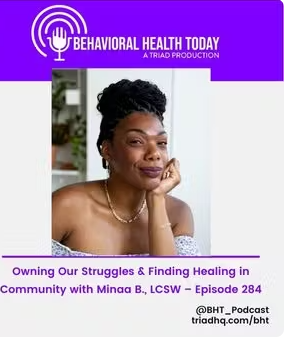2 Social Media Sites (Besides Facebook) for Marketing Your Therapy Practice
2 Social Media Sites (Besides Facebook) for Marketing Your Therapy Practice
 Are you ready to level up your social media marketing?
Are you ready to level up your social media marketing?
For obvious reasons, Facebook is a good starting point for marketing your private practice on social media. Nearly 80 percent of U.S. internet users log in regularly. That means if your clients and potential clients use the internet, they’re on Facebook.
But where do you go after Facebook? Other social media sites may boast fewer regular users than Facebook, but the most popular among them can still be valuable channels for attracting and connecting with new clients.
It all depends on who you’re targeting. If you work primarily with seniors, for example, you may want to steer away from Instagram. Only 16 percent of adults over 50 say they use the site. On the other hand, Instagram is a hit among young adults; 71 percent of 18- to 24-year-olds say they use it.
If most of your clients come from a higher income group, LinkedIn might be the channel for you. Among those that earn more than $75,000 per year, LinkedIn beats out Instagram, Pinterest, and Twitter.
If you’re ready to move beyond Facebook marketing or your market research has revealed opportunities on other social media platforms, read on. Here we’ll introduce the two best non-Facebook social media sites for marketing your private therapy practice.
| Are you looking for a more comprehensive guide on marketing for therapists? Then click here to view our 6,000+ word web guide. It's free! |
1. Twitter
Given its ubiquity in politics, the media, and celebrity culture, you may think Twitter is the next obvious choice for marketing your practice online after Facebook. Rarely does a day go by when you don’t hear about an infamous Tweet or a trending hashtag. Everyone must be on Twitter.
But everyone is not on Twitter. In fact, while 87 percent of Americans have heard of Twitter, only 7 percent actually use it. So consider your audience wisely before investing your time heavily in Twitter marketing.
What is it? Boiled down to its essence, Twitter is a site (and a mobile app) for sharing quick thoughts and following the quick thoughts of others. Individual posts, aka, tweets, are limited to just 280 characters or less. To get a feel for that, this paragraph is 280 characters.
As with Facebook, you can follow other people’s Twitter feeds and others can follow yours. But following in Twitter works a bit differently than friending on Facebook.
While it’s possible to have a private Twitter profile, most users stick with the default public profile. This allows anyone to view your feed, whether they’re signed into Twitter or not. You also don’t need permission to follow someone’s public Twitter feed.
The Twitter world has its own conventions and etiquette. If you’re going to dive into Twitter, it’s best to start by learning the rules of the road — from hashtags to retweets. Start with Twitter’s helpfully named guide, “Getting Started.”
How is it useful? You hear so much about Twitter because it is the internet’s hub of conversation. Along with the big trending topics, there are millions of smaller niche conversations going on among hyper-engaged users.
Of course, as a therapist, you don’t necessarily want to be drawn into direct conversations with potential and current clients. Privacy laws and ethical considerations prevent that. But you can use Twitter to:
- Engage with other therapists and healthcare professionals in thoughtful discussions that can lead to referrals.
- Share helpful content (including your own) with potential clients and other therapists.
- Give potential clients a window into your style and thinking process.
2. LinkedIn
Because most of us use it for work, finding work, and networking, we don’t always think of LinkedIn as a social media site. But it is actually one of the internet’s oldest and most trafficked. Founded way back in 2003, LinkedIn now has over half a billion members.
What is it? If you haven’t used LinkedIn but have used Facebook, you’ll feel right at home. The two sites function similarly, except with LinkedIn, you don’t “friend” people. You “connect” to them.
The difference is the focus on your professional life. You wouldn’t share your vacation pics or silly dog stories on LinkedIn. Instead, LinkedIn is a place for sharing insights from your work, your thoughts on industry trends, and job openings.
Your LinkedIn profile is like your resume. Among other things, it tells others where you’ve worked before, where you trained, and what you’ve achieved professionally. People with whom you’ve worked can also write recommendations for you and post them on your LinkedIn profile.
How is it useful? For private practice therapists, the best way to use LinkedIn is to generate referrals.
Especially if your practice is new, you might want to search LinkedIn for other healthcare providers in your area. Connect with them and (respectfully) start a conversation about the need for mental health services and how you can help.
There may already be LinkedIn groups organized in your area for that very purpose. Learn how to find and join LinkedIn groups here.
LinkedIn may also be useful if you’re looking to extend your brand as an expert in your mental health specialty, landing high profile speaking and guest posting opportunities.
Other Ways to Market Your Private Practice Online
Some therapists love making connections, sparking conversations, and sharing ideas and experiences on social media. Others stay away from social media because of privacy concerns or because of the amount of time and effort it takes to make social media marketing pay off. Fortunately, there are other ways to attract new clients and promote your practice online.
Learn about creating a website, building a referral network, and spreading your influence with our complete guide for therapy professionals, “Marketing for Therapists.”









